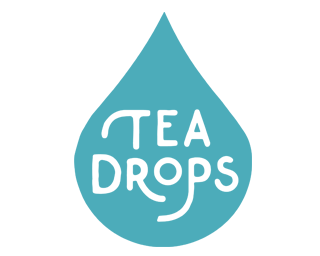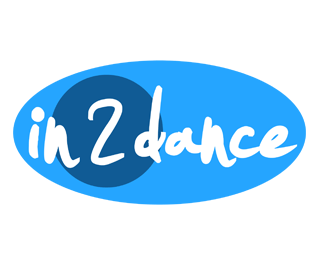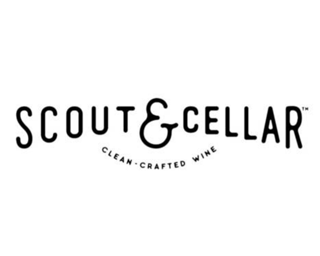Self Care Between Sessions
September 5, 2023An active approach to taking control of your wellness.
As a Licensed Massage Therapist that has been practicing since 2017, I have learned many easy and affordable at home self care techniques. Self care does not have to be complicated or daunting. Some of the most simple and intuitive things can be profoundly helpful when done consistently. These suggested techniques allow the body to continue to correct itself between bodywork sessions. They can also be an enhancement to any wellness or exercise routine. You can take self care into your own hands!!
Hot and Cold Therapy
There are many benefits of both hot and cold therapy. It is something that many people forget that they can apply themselves at home. I would argue utilizing cold is one of the more forgotten pain relief aids. While heat can aid in relaxation and loosening muscular tension, cold is a great way to relieve the swelling and inflammation that can cause pain and discomfort.
Research has shown that taking a 3 minute cold shower daily can help to boost your immune function, relieve muscle soreness, decrease recovery time between workouts, improve circulation and more. For those who don’t feel like jumping into a cold shower, cold compresses are great for treating local aches and pains, and decreasing swelling or inflammation that may be associated with a recent injury. Overall, using cold is typically much better for acute pain (think of waking up with a sore neck or muscle soreness from doing too much yard work), strains and sprains and helping to increase recovery time.
Heat, on the other hand, is great for chronic aches and pains. When used locally, like with a warm compress or heating pad, it will increase circulation to the area and have an overall relaxing effect. Hot tubs and Hot showers are also a commonly utilized heat therapy.
Easy ways to utilize hot/cold therapy
Cold Pack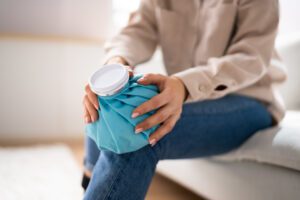
Cold shower (3 min)
Ice Bath (research before attempting)
Heat packs
Hot showers (don’t go too hot!)
Warm Compresses (moist heat is very different than dry heat)
Incorporating hot or cold into a massage (Think hot/cold stones)
Personally, I am a fan of the hot/cold packs that you can buy. You either freeze or microwave for the desired temperature. Some things that most of us have on hand are a bag of frozen peas, or rice to put into a sock to use for a hot pack. I always have a rice sock on hand to throw in the microwave (60 seconds) to use when I need a little tension relief in my shoulders. Adding a couple of drops of essential oils to the sock after heating can elevate the experience.
Tennis balls and Trigger Points
We are all familiar with that sensation when a skilled massage therapist rolls over a trigger point with a thumb or an elbow. A common response is “I didn’t even know that part of my body was sore!”. Trigger points, sometimes known as knots, are areas in the muscle or connective tissue that are chronically tight, have adhesions through the tissue or have various ranges of distorted sensitivity. Trigger points often have pain referral patterns, but can vary on how they feel, depending on the person.
The most common technique to relieve trigger points is deep, static pressure. Massage therapists or PTs may use fingers, knuckles or elbows. Fortunately, there are cheap and effective at home tools that you can experiment with to get some relief between bodywork sessions.
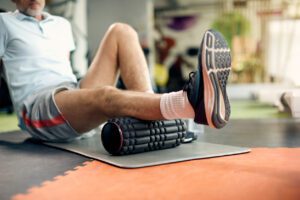 Tennis balls are extremely effective in targeting trigger points on the back, shoulders, glutes and hamstrings. Tying off a couple of tennis balls in a sock makes positioning them behind you while standing much easier. Trigger point canes are helpful as well. “Theracane” is a popular brand. Using the corner of a wall can be just as effective, and much cheaper. Foam rollers or rolled up towels can be used while on the floor for firm deep and consistent pressure that may help your body to release the tension of the trigger point.
Tennis balls are extremely effective in targeting trigger points on the back, shoulders, glutes and hamstrings. Tying off a couple of tennis balls in a sock makes positioning them behind you while standing much easier. Trigger point canes are helpful as well. “Theracane” is a popular brand. Using the corner of a wall can be just as effective, and much cheaper. Foam rollers or rolled up towels can be used while on the floor for firm deep and consistent pressure that may help your body to release the tension of the trigger point.
A few things that can be utilized to tackle those bothersome trigger points. Many of these can be found in pharmacies, sporting goods stores and you may even have some at home.
Tennis Balls
Dryer Balls (I prefer these for the amount of give they have)
Foam Rollers
Trigger point canes
One technique I will use between clients on myself is to grab a tennis ball, find a tight spot (around the shoulder blades is always a winner) and just lay flat with the ball positioned under the tight or tender spot. Holding for 3-5 minutes is a good place to start. Sometimes the body needs a little more time to relax around the tool you are using.
Silicon Cups
One thing I recommend to many of my clients is to look into silicon cups to use at home. Silicon cups can be used to help manage scar tissue, adhesions, and tight muscles. There are many online tutorials with more in depth instruction. Ultimately, listen to your body and use common sense.
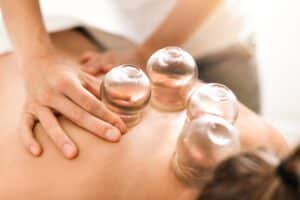
Cupping helps to stretch and pull the tissue as opposed to compression down into it. This can be wonderful to work and release stubborn areas. Cupping also moves a lot of fluid through the area and can stimulate lymphatic flow. In this way, cups can enhance the detox effect normally brought on by active or passive bodywork. There are several cupping styles and types of cups, but for at home use, silicon cups are the easiest to utilize.
Cupping can help with
Detox
Breaking down stubborn connective tissue
Increasing range of motion
Post workout recovery
Scar tissue mobilization
I frequently will put cups along the tops of my shoulder/trapezius area. Cups can move across the area or stay static. 15-20 minutes is the max for a static cup. If you don’t mind having a few cupping marks, this is one of my most recommended at home self care for clients.
Get creative and see what simple techniques you can incorporate into your wellness routine!
There are many other honorable mentions. Regular exercise, yoga, walking, proper hydration, good nutrition and getting enough sleep are a few. As always, make sure to check with your primary care doctor before incorporating any new selfcare or exercise routines. The idea is that we are all able to become empowered in our own healing journey. Self care plays a huge role in that empowerment. What type of self care have you done recently? How would you like to improve your self care routine? What simple things can be incorporated to help you take care of YOU more effectively?

